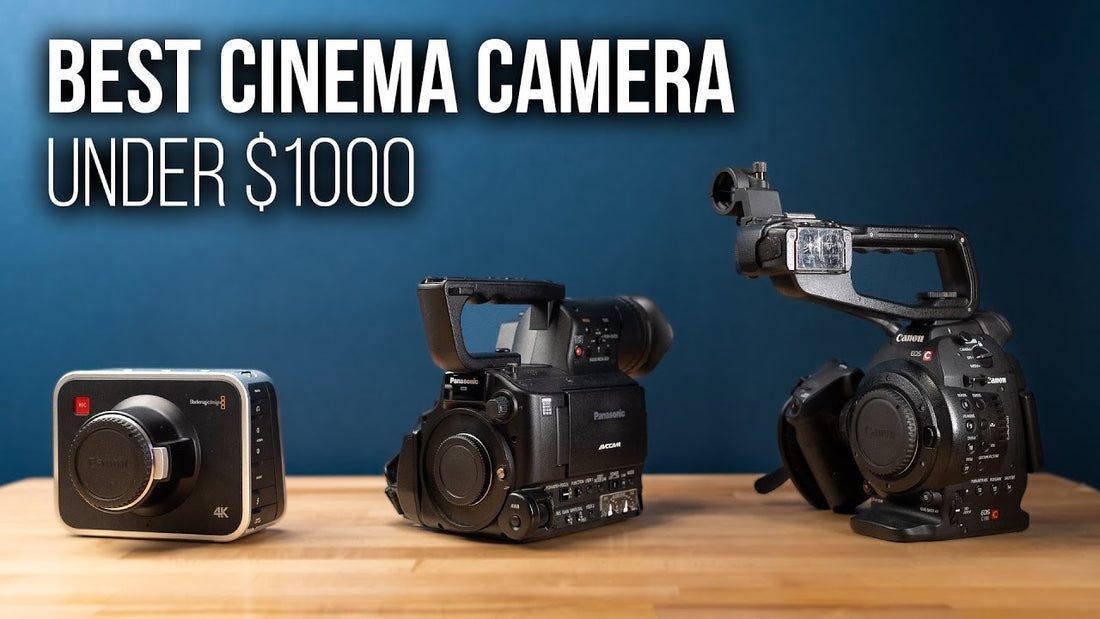
Best Budget Cinema Camera Under $1,000 | Head To Head Comparison
Check out my full video HERE
This post contains affiliate links. If you click and make a purchase, I may earn a commission at no extra cost to you. Thanks for your support!
Introduction
In the world of cinema cameras, “budget-friendly” usually means spending a few thousand dollars. But what if you only have around $1,000 to invest in a serious filmmaking tool? While today’s market is flooded with cameras costing well over $2,000—and often tens of thousands—there are still older yet powerful cinema cameras that deliver professional-level features and image quality at under $1,000 on the used market.
In this comprehensive comparison, we’re looking at three such options. Each once retailed for a premium price, but with time (and newer models pushing them out of the spotlight), these cinema cameras now sit comfortably under the $1,000 mark. We’ll examine their specs, ergonomics, dynamic range, codecs, assist tools, and more. By the end, you’ll know which camera might be the perfect fit for your shooting style.
Meet the Contenders
-
Canon C100 (2012)
- Mount/Sensor: EF mount, Super 35 (1.5x crop)
- Video Specs: 1080p at 24/30p, 8-bit 4:2:0 internal (4:2:2 via HDMI), up to 12 stops of dynamic range, built-in NDs (2/4/6 stops), dual SD card slots
- Used Price: $800-$1,000
- Ideal For: Run-and-gun, documentary, corporate events
-
Blackmagic Production Camera 4K (2013)
- Mount/Sensor: EF mount, Super 35 (1.7x crop)
- Video Specs: 4K up to 30p, 10-bit ProRes 422 or 12-bit RAW, about 12 stops of dynamic range, no built-in NDs, uses 2.5" SSDs
- Used Price: $800-$1,000
- Ideal For: Narrative filmmaking, controlled environments, projects needing RAW or high-bit-depth footage
-
Panasonic AF100 (2010)
- Mount/Sensor: Micro Four Thirds mount, 2x crop
- Video Specs: 1080p up to 60p (in VFR mode), 8-bit 4:2:0 internal (4:2:0 out via HDMI), around 10 stops of dynamic range, built-in NDs, dual SD card slots
- Used Price: $600-$800
- Ideal For: Multi-camera events, basic slow-motion needs, budget-conscious shooters
Key Comparisons
Resolution & Frame Rates:
- C100: 1080p only (24/30p), but high-quality downsampling from a 4K sensor results in sharp HD.
- Blackmagic 4K: True 4K at 24/30p, plus CinemaDNG RAW and ProRes 422 HQ. Fantastic for grading, but no slow motion above 30p.
- AF100: 1080p with up to 60p slow-motion (VFR). Low dynamic range, but if you need basic high frame rates, this is your only option here.
Dynamic Range & Codec Quality:
- C100: Up to 12 stops with C-Log, but 8-bit 4:2:0 internal. Good for doc work, less ideal for heavy grading.
- Blackmagic 4K: About 12 stops, 10-bit ProRes and 12-bit RAW for ultimate grading flexibility. Best choice for narrative projects.
- AF100: ~10 stops. Standard 8-bit 4:2:0. More limited for extensive color work.
Ergonomics & Features:
- C100: Built like a true cinema camera—rotating side grip, handle with XLR inputs, built-in NDs, dual SD slots. Super user-friendly.
- Blackmagic 4K: A metal box with a fixed touchscreen and no handle or NDs. Amazing image quality, but you’ll need rigging for comfortable use.
- AF100: Similar form factor to the C100 with built-in NDs, dual SD slots, and XLR inputs. Fully articulating screen, but ergonomics not as refined as Canon’s.
Audio Capabilities:
- C100 & AF100: Two XLR inputs, headphone jack, physical audio controls. Perfect for pro audio setups.
- Blackmagic 4K: Two 1/4" inputs, less standard than XLR. Need adapters and menu-based controls for gain. More cumbersome for audio pros.
ISO & Low-Light:
- C100: Great low-light up to ISO 2000 or so.
- Blackmagic 4K: Best at ISO 400. ISO 800 gets noisy fast.
- AF100: Lowest performance in low-light; try to stay at 320 ISO. Not great for dim environments without lighting.
Battery Life:
- C100: Exceptional—around six hours on a single battery.
- AF100: About three hours per battery, still respectable.
- Blackmagic 4K: Weak internal battery life (~45 minutes). External power solutions recommended.
Who Wins?
Overall Best: Canon C100
If you need a camera that’s a joy to use in run-and-gun scenarios, documentaries, or corporate interviews, the C100 checks all the boxes. Ergonomic design, built-in NDs, dual SD slots, great battery life, and XLR inputs make it the best all-rounder.
Best for Narrative & Grading: Blackmagic Production 4K
For indie filmmakers who want RAW or high-bitrate ProRes, this camera offers incredible grading flexibility and a more cinematic look. It demands more setup (rigging, external power, possibly external NDs), but the final image can look truly cinematic.
Budget Slow-Mo & MFT Flexibility: Panasonic AF100
The AF100 might be overshadowed by the other two cameras, but it’s still a solid workhorse. It’s cheaper, can shoot up to 60p slow motion (albeit in a limited format), and uses the MFT mount for tons of lens options. Just don’t expect the same dynamic range or low-light performance.
Final Thoughts
All three cameras provide professional-level features at a fraction of their original cost. If you want a no-fuss cinema camera ready for almost any job, go for the Canon C100. For indie narratives and top-notch color work, the Blackmagic Production 4K shines. Need something even cheaper with versatile lens options and occasional slow motion? The AF100 still has a place.
